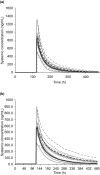A Physiologically Based Pharmacokinetic Model to Predict Potential Drug-Drug Interactions and Inform Dosing of Acumapimod, an Oral p38 MAPK Inhibitor
- PMID: 33107218
- PMCID: PMC7825188
- DOI: 10.1002/psp4.12565
A Physiologically Based Pharmacokinetic Model to Predict Potential Drug-Drug Interactions and Inform Dosing of Acumapimod, an Oral p38 MAPK Inhibitor
Abstract
Acumapimod, an investigational oral p38 mitogen-activated protein kinase inhibitor for treatment during severe acute exacerbations of chronic obstructive pulmonary disease, is metabolized primarily by cytochrome P450 3A4 (CYP3A4) and is a P-glycoprotein (P-gp) substrate. Concerns about drug-drug interactions (DDIs) have meant patients receiving drugs that inhibit CYP3A4 were ineligible for acumapimod trials. We report on how 2 acumapimod clinical DDI studies and a physiologically-based pharmacokinetic (PBPK) model assessing how co-administration of a weak (azithromycin) and strong (itraconazole) CYP3A4 inhibitor affected acumapimod systemic exposure, informed decision making and supported concomitant use of CYP3A4 and P-gp inhibitors. Studies MBCT102 and MBCT103, respectively, demonstrated that co-administration of azithromycin or itraconazole had no clinically meaningful impact on acumapimod pharmacokinetics. Findings were consistent with PBPK model results. Safety profiles were similar when acumapimod was co-administered with azithromycin or itraconazole. These studies highlight the value of PBPK modeling in drug development, and its potential to inform DDI investigations.
© 2020 Mereo BioPharma 1 Limited. CPT: Pharmacometrics & Systems Pharmacology published by Wiley Periodicals LLC on behalf of the American Society for Clinical Pharmacology and Therapeutics.
Conflict of interest statement
A.A. reports personal fees from Mereo BioPharma, Takeda, and Pfizer outside the submitted work. C.F. is an employee of ICON Clinical Research. W.M., and J.P. are employees of Mereo BioPharma.
Figures




Similar articles
-
An Open-Label Study to Assess the Effect of Itraconazole and Rifampin on Parsaclisib Pharmacokinetics When Administered Orally in Healthy Participants.J Clin Pharmacol. 2020 Nov;60(11):1519-1526. doi: 10.1002/jcph.1653. Epub 2020 Jun 9. J Clin Pharmacol. 2020. PMID: 32515832 Free PMC article. Clinical Trial.
-
Phase II Study of Single/Repeated Doses of Acumapimod (BCT197) to Treat Acute Exacerbations of COPD.COPD. 2019 Dec;16(5-6):344-353. doi: 10.1080/15412555.2019.1682535. Epub 2019 Nov 4. COPD. 2019. PMID: 31682162 Clinical Trial.
-
Drug-drug interaction (DDI) assessments of ruxolitinib, a dual substrate of CYP3A4 and CYP2C9, using a verified physiologically based pharmacokinetic (PBPK) model to support regulatory submissions.Drug Metab Pers Ther. 2019 May 30;34(2):/j/dmdi.2019.34.issue-2/dmpt-2018-0042/dmpt-2018-0042.xml. doi: 10.1515/dmpt-2018-0042. Drug Metab Pers Ther. 2019. PMID: 31145690
-
Pharmacokinetic and pharmacodynamic drug interactions with new oral anticoagulants: what do they mean for patients with atrial fibrillation?Ann Pharmacother. 2013 Nov;47(11):1478-87. doi: 10.1177/1060028013504741. Epub 2013 Oct 9. Ann Pharmacother. 2013. PMID: 24259602 Review.
-
Predicting drug-drug interactions involving the inhibition of intestinal CYP3A4 and P-glycoprotein.Curr Drug Metab. 2010 Nov;11(9):762-77. doi: 10.2174/138920010794328922. Curr Drug Metab. 2010. PMID: 21189139 Review.
Cited by
-
Role of p38 Mitogen-Activated Protein Kinase in Asthma and COPD: Pathogenic Aspects and Potential Targeted Therapies.Drug Des Devel Ther. 2021 Mar 23;15:1275-1284. doi: 10.2147/DDDT.S300988. eCollection 2021. Drug Des Devel Ther. 2021. PMID: 33790539 Free PMC article. Review.
References
-
- Wedzicha, J. , MacKinnon, A. & Parkin, J. Effectiveness of acumapimod oral p38 inhibitor in the treatment of acute severe exacerbations of COPD: results of the AETHER phase II trial. Am. J. Resp. Crit. Care Med. 197, A7710 (2018).
-
- MacNee, W. , Allan, R.J. , Jones, I. , De Salvo, M.C. & Tan, L.F. Efficacy and safety of the oral p38 inhibitor PH‐797804 in chronic obstructive pulmonary disease: a randomised clinical trial. Thorax 68, 738–745 (2013). - PubMed
Publication types
MeSH terms
Substances
LinkOut - more resources
Full Text Sources
Miscellaneous

